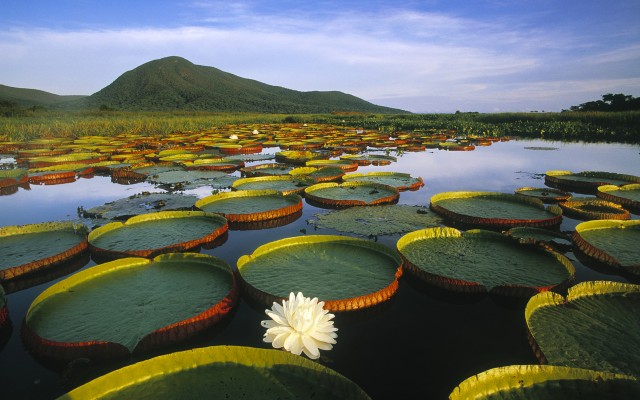Pantanal
LOCATED IN SOUTH-CENTRAL BRAZIL and extending into the adjacent parts of BOLIVIA and PARAGUAY, the Pantanal is the world's largest wetland. It can expand during the rainy season to cover about 77,000 square mi (200,000 square km), which is about one-third the size of FRANCE. Water depths may exceed 18 ft (6 m), with only the highest ground escaping inundation at this time. Water levels recede about 13 ft (4 m) during the dry season.
Rainfall in this part of South America totals 40 to 60 in (100 to 150 cm) per year, most of it concentrated in the hot months of November to April. The climatic impact of the Pantanal extends far beyond its boundaries. It acts as a giant sponge, receiving rainfall during the wet season and then releasing moisture to the atmosphere during dry spells. Climatologists assert that nearby areas would become less habitable if it were not for this store-and-release mechanism.

The Pantanal is an immense reservoir of biological diversity. It contains an astounding variety of plant life. Floating plants cover huge areas. A rich layer of silt supports many aquatic plants. On higher ground, bushy vegetation called cerrado predominates. Palm trees and fig trees punctuate these landscapes. Trees may form galleries along the banks of some rivers (gallery forests).
The aquatic vegetation supports large numbers of animals. Scientists have already identified over 650 species of birds such as the colorful macaw, 250 species of fish, 80 mammals, and 50 reptiles in this ecological paradise. Aquatic birds such as ducks filter small animals and algae from the water. Herons have established large colonies in trees along the riverbanks. They and storks feed primarily on fish, frogs, snails, crabs, and insects. The Pantanal is home to thousands of varieties of butterflies and a myriad of other insects. Larger animals living here include capuchin and howler monkeys, tapirs, capybaras, giant river otters, jaguars, caimans, and anacondas.
Despite the difficulty of access in this part of South America, the region's resources have attracted a great deal of attention, not all of it welcome. For example, poachers unlawfully kill caimans for their skins and capture macaws for export to Northern Hemisphere customers. Although reptile-breeding farms have helped reduce the illegal export of caiman skins, the Brazilian government lacks the resources to effectively combat the poachers. The arrival of commercial fishing boats, supported by refrigerated trucks, has complicated the problem of protecting natural resources here.
In addition, cattle ranchers have recently expanded operations on the margins of the Pantanal. The ecological impact of about 4 million cattle on these ranches has been considerable. For example, ranchers have removed cerrado vegetation from interfluves, leading to increased silting of rivers such as the Taquari. Farmers wishing to cultivate rice, sugarcane, and soybeans have also had a negative impact upon the natural environment. Mercury pollution from gold mining and sewage from nearby cities such as Cuiaba add to the problem. Fish absorb the toxic mercury, which is then passed up the food chain by fishermen and fish-eating birds.
The Pantanal is drained by the Paraguay River to the south and by tributaries of the AMAZON RIVER to the north. Cable News Network reported in April 1997 that engineers have proposed dredging a waterway to connect the two river systems. Proponents say that the proposed Hidrovia project would lower transportation costs and provide a vital transportation link between members of the MERCOSUR trading block.
Opponents assert that the project would be an ecological catastrophe, draining the Pantanal, killing many of the area's plants and animals, and negatively impacting the Native Americans living there. So far, the Brazilian government has yet to approve the Hidrovia project.